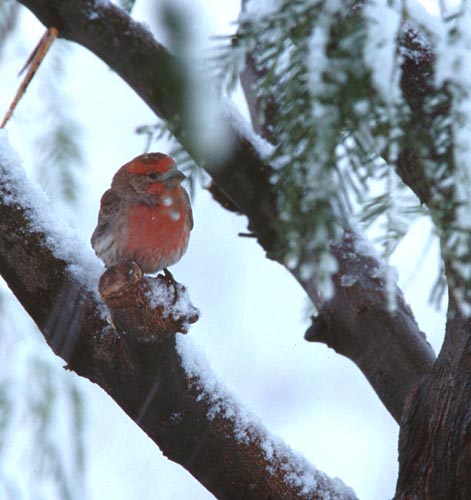|
| Query: bird | Result: 1221st of 32675 | |
Re: request pictures of Cardinals. (red bird)
| Subject: | Re: request pictures of Cardinals. (red bird)
| | Poster: | "Shirley Curtis" (sowhat@NOSPAMazstarnet.com)
| |

| File size : 48295 bytes
File date : 2001:01:08 22:35:10
Resolution: 471x500
Jpeg process : Baseline
Posted Newsgroups: alt.binaries.pictures.animals
Posted Date: Wed, 3 Jan 2001 21:58:50 -0700 |
Re: request pictures of Cardinals. (red bird)
OK, we _do have snow, but it's not "real". We had seven inches in November
of 1971 and two inches on Christmas Day of 1986. We had some on Easter
Sunday a couple of years ago. I took pictures of the birds fighting at the
bird feeder. They went through 15 pounds in just a few hours. Poor little
things. They didn't even notice me when I went out to take pictures of
them.
Here's one of a tiny finch fluffed to the max. Taken from about 10% of a
slide. It's not that good.
I like Mt. Lemmon for cooling off as it's always a good 25 degrees cooler up
there. It was 70+ today but will get cold - 62 by the weekend. Did you go
to the U of A here?
sc
"Rebecca Willey" wrote in message
news:LER46.191127$4K4.30910102@typhoon.southeast.rr.com...
> whaddya mean you don't "do snow" in Tucson, I had it snow 3 inches deep once
> when I was there! Of course the temperature shot up and it all melted, but
> it was cool! :)
>
> Or you could drive 45 minutes up to the mountain's snow line. It always
> amazed me, drive up and play in the snow, and then drive down and have lunch
> out on the terrace!
>
> Sorry, just reminiscing!
>
> ;)
> Rebecca
>
>
Finch#2.jpg |
^o^
Animal Pictures Archive for smart phones
^o^
|
|

